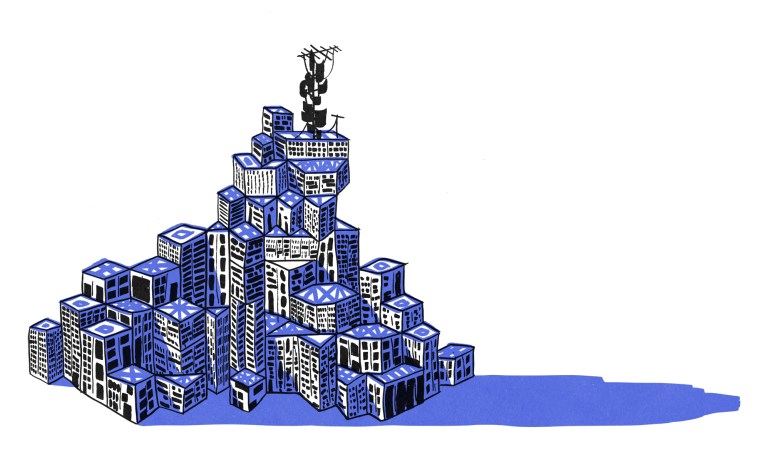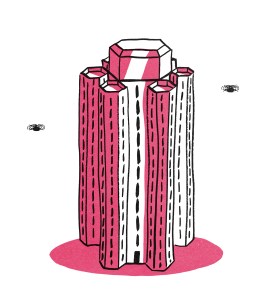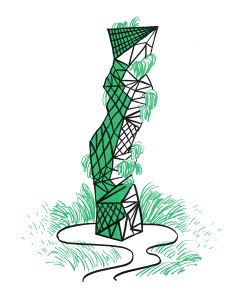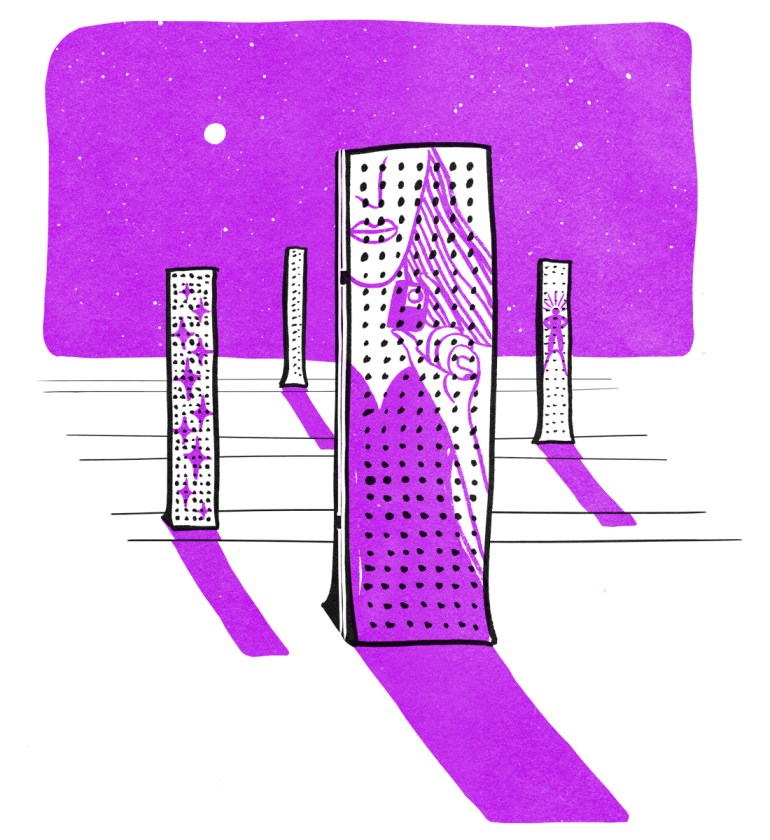Some among my readers may recall a dreadful incident, created by a dark genius of political theater, in September of 2001. This dismal act involved aircraft and skyscrapers. It so transfixed the public imagination that some feared skyscrapers would no longer be built.
Over a dozen years later, and we can see: quite the opposite came to pass. Skyscrapers multiplied in many locales never before graced with their presence. They showed impressive formal vitality, in a startling panoply of unheard-of shapes and stylings.
Today’s supertall structures, seen objectively, are risky, daring, even rather scary. Yet they inspire no apparent fear; the public greets them with kindness and complacency.
There are some complaints, of course, those standard complaints: the aggressive, thrusting showiness, the lack of a straightforward business model, the spoilt views of historic skylines. Identical things were said about the Eiffel Tower in the 1880s.
Old-fashioned complaints rarely pose big problems for innovators. Technologies in real trouble with society — nuclear power, for instance — are continually generating new, exciting complaints. Skyscrapers, even the tallest ones, are becoming urbane.
The newer ones have looser floor-plans, a wider variety of uses and users; more cozy creature-comforts, less of the boxy, steel-framed swaying and creaking. In short, they’re a modern case study in good old-fashioned technological advance. Novelty abounds in skyscraperdom today. New design methods, stronger materials, advances in building management, exotic fabrication methods, political smart-city initiatives — these promise a host of surprises.
So this is a fun time for skyscraper speculations. I may mention that, as I write, I just got through with a lively project for Arizona State University, involving a tower seventeen kilometers high. This would seem to be the tallest possible structure that is buildable with today’s methods and materials. This notion has been a pleasant locus for some Arthur C. Clarke-style aerospace engineering by us sci-fi writers. I can’t help but tell you that this imaginary edifice would weigh twelve million tons, and it would likely have to be extruded upward from the planet’s surface, from some desert test-bed… But never mind: that’s all science fiction.
Today’s supertalls may boggle the mind, but they are stunningly factual, immediately obvious, impossible to overlook. It’s their children, the unbuilt towers of futurity, that are surrounded by a dense, foggy haze of harbingers. Futurist scenarios can prove useful here. Scenarios cause loose ideas to separate and clump into trends.
I’ll do a little quadrant-work in my brief essay here, and describe four differing yet plausible classes of future skyscraper. Let’s choose a twenty year time-frame: the 2030s.
Let’s imagine we have two slider-bars that change the world we know: one for the state of skyscraper technology, high-tech or lower, and the other for the political and economic climate. We’ll start with a scenario that might seem counterintuitive: a sharp reaction against the trends of the past two decades.
Future skyscraper #1: Huge, lopsided pyramid
In this scenario, today’s variety of supertalls, those glossy spires of the wealthy Gulf states and an emergent China with a lot to prove, are considered archaic failures. They are white elephants — stodgy, overwrought, beside the point. The baton of great construction has been passed to much younger cities, the world’s biggest and fastest-growing urban clusters, in Brazil, India, and Africa. These cities struggle to house colossal floods of urban immigrants by the cheapest and fastest means possible.
 They’re not rich enough to burn money like oil, but they do have plenty of labor power, plus some new, digital means of social organization. The results are huge, pyramidal, and lopsided, rather than supertall, spindly, and elegant. These are crowd-funded super-favelas, a kind of Kowloon Walled City on steroids. These socially innovative yet low-tech structures are plug-in and pre-fab, fast-rising and poorly regulated, with an anarchic Internet philosophy of small pieces loosely joined. Ugly and cheap, yet immeasurably vast, they teem with human vitality. Power is solar and piezoelectric. Water and sewage are iffy. Streets are nameless. The police travel the crooked alleys in well-armed squadrons.
They’re not rich enough to burn money like oil, but they do have plenty of labor power, plus some new, digital means of social organization. The results are huge, pyramidal, and lopsided, rather than supertall, spindly, and elegant. These are crowd-funded super-favelas, a kind of Kowloon Walled City on steroids. These socially innovative yet low-tech structures are plug-in and pre-fab, fast-rising and poorly regulated, with an anarchic Internet philosophy of small pieces loosely joined. Ugly and cheap, yet immeasurably vast, they teem with human vitality. Power is solar and piezoelectric. Water and sewage are iffy. Streets are nameless. The police travel the crooked alleys in well-armed squadrons.
Peasant habits persist in little urban farms and chicken-coops. Scrappy, vernacular building methods are learned from video instructables, conveyed by open-source handheld devices. The building materials are recycled steel rebar and bleak microfiber cement, splashed with vivid tropical paints to break the monotony. Building Information Management is alien and unheard-of. The locals pride themselves on the sort of ingenuity-under-duress known in India as jugaad — and on unashamed piracy. The bottom billions are a vast global majority, rising on crooked iron stairs.
Future skyscraper #2: No-nonsense, mil-spec fortress
In our second scenario, technology is similarly limited, but a different social logic prevails. It’s sterner and more authoritarian in flavor, in established cities dominated by anxious people who feel they have a lot to lose. Violent weather is of grave concern. Seaside cities suffer storm floods, while tall towers suffer freak wind-loads.
 The newer style of tower is therefore fortress-like. These urban castles have a no-nonsense, mil-spec look: sturdy, dignified, and disciplined, with legible architectural features that visibly promise not to fall into pieces. These are not glossy showpieces for the public eye gazing up from the street. These panoptic towers are the high-ground. They are watchtowers, and they surveil the city with care, using canny methods borrowed from the drone industry and social-media surveillance marketing.
The newer style of tower is therefore fortress-like. These urban castles have a no-nonsense, mil-spec look: sturdy, dignified, and disciplined, with legible architectural features that visibly promise not to fall into pieces. These are not glossy showpieces for the public eye gazing up from the street. These panoptic towers are the high-ground. They are watchtowers, and they surveil the city with care, using canny methods borrowed from the drone industry and social-media surveillance marketing.
Management systems haunt every tower, and they’re of an aggressive, suspicious design, fully integrated with city police and national intelligence services. The disgruntled have launched cyberwar attacks: by seizing digital control of the towers’ tuned-mass dampers—anti-sway counterweight systems—enemies can swing the towers violently, terrifying the occupants with artificial earthquakes.
Future skyscraper #3: Colossal, awkward tower
 In our third scenario, Building Information Modeling is exceedingly advanced, and it has carried urban society with it toward a complex technocracy. The watchwords here are software code, regulation, decency, fairness, justice, and endless niggling confrontations with the networked shareholders. Towers are colossal, but they’re warped into weird shapes by demands for light rights and viewing corridors. Luckily, parametric engineering is so advanced that buildings have little trouble contorting themselves to meet irrational political demands. Awkward and apologetic, these supertalls have museum-style, skeuomorphic detailing fit to please King Charles III.
In our third scenario, Building Information Modeling is exceedingly advanced, and it has carried urban society with it toward a complex technocracy. The watchwords here are software code, regulation, decency, fairness, justice, and endless niggling confrontations with the networked shareholders. Towers are colossal, but they’re warped into weird shapes by demands for light rights and viewing corridors. Luckily, parametric engineering is so advanced that buildings have little trouble contorting themselves to meet irrational political demands. Awkward and apologetic, these supertalls have museum-style, skeuomorphic detailing fit to please King Charles III.
Sustainable environmentalism has been baked into the regulations, aided and abetted by regulatory capture by the biggest global vendors. The rights delays can cause cost overruns, but the general financial picture for big building is sturdy and predictable. These towers rise slowly and steadily. They are great places to live on a pension: they’re decent, healthy, well-lit, dependably serviced, and wheelchair-friendly, with eager tenant questionnaires twice a week.
Future skyscraper #4: Postindustrial, digitized monster
In our last scenario, the Smart City has conquered all it sees. Architecture slavishly follows the postindustrial logic of the dominant titans of the era: Samsung, Apple, Huawei, Amazon, Google, Facebook. National and urban legal structures have been undercut, bankrupted and disrupted by the great networks. The Dumb Cities of the past are proved archaic, just too slow — stumbling blocks routed around by the process flows. Humming cloud barns are the new factories, package distribution centers are the new megamalls. Fully-privatized digital “enterprise zones” flourish in the once-hallowed city halls, while new supertalls have become prestigious follies for elaborate digital empires.
Bizarre experiments flourish. Everyday objects are unnecessarily digitized, in much the way that pencil sharpeners used to be streamlined. Walls and floors are made of ultralight carbon-fiber, vibrating like drumheads. Elevators are fired up and down like big plastic bullets, and woe to the occupants’ over-pressured ears. Touchscreen building skins act as monster billboards, where the rival skyscrapers flame and screech at one another. Little courier robots, zipping along on their generic Googlemaps, are becoming more common than rats.
Some towers go rent-free to occupants, if they’re willing to abandon their privacy entirely to the prurient landlord. Augments haunt the halls and streets; it’s considered chic to remove all the visible, touchable controls, restricting access to the handheld devices of tenants. Doorways, and even the sidewalks, argue with the derelicts, Siri-style.
This bounty of features comes at a price: severe instability and cruelly rapid obsolescence. Real estate is a casino; whole cities go bust with the slick invisible ease of Facebook annihilating MySpace. The City of Oz is splendid, but the Wizard of Oz, for all his greatness and power, is one phosphor-dot thick.
Building scenarios is rather like throwing Tarot cards. The spirit of the times, the zeitgeist, is like one hand assembled from the deck of history. As with any card game, it’s combinatorial, and multifactorial.
When a zeitgeist changes with the passing of years, it is not abolished or disproved forever; it merely retreats into the quiet darkness of the deck, awaiting future probabilities. A battle among four scenarios, like the ones I described here, is rather like a four-player poker hand. Yes, they’re all mere gambles, mere speculations, yet they’re not of equal value. Among those four, one will predominate.
A skyscraper is a multiplex, archetypal symbol, rather like some vast, freestanding Tarot card. A tower conveys a meaning, yet that meaning shifts with every new deal.
The Eiffel Tower is of particular interest here, not because it’s new, but because it’s so old. The Eiffel Tower has been a sideshow freak and also a treasured icon. It has been the steely product of the white-hot forge of high technology, and also a cherished antique. From its very birth, the Tower had admirers who wished it immortality, and even today, you could find a few Parisians who despise it, resent it, and wish it were gone. The steel and rivets Eiffel left may not change much, but we do. Then we surprise ourselves with our own perversity, gather the cards to our chests, and we pick up where we left off. All in the fullness of time.
This essay was excerpted from The Future of the Skyscraper, published by Metropolis Books as part of the SOM Thinker series.
Illustrations by Hannah K. Lee for TED.













